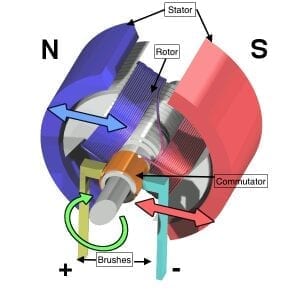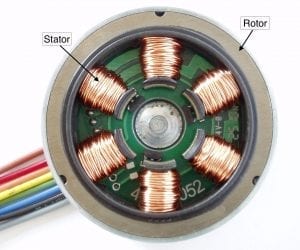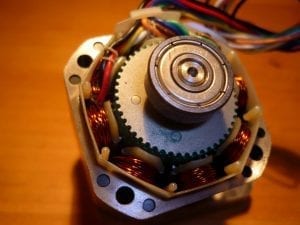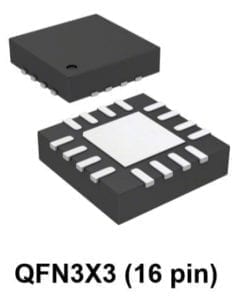ST recently broke the record for the world’s tiniest single chip motor driver by shrinking the packaging of three of its chips to 3 mm x 3 mm. Aside from the amazing fact that this means the components are shorter than a grain of rice, it opens the door to smaller, and lower-consumption designs. The three full-featured motor drivers belong to the STSPIN family of products. They are the STSPIN240, STSPIN230, and STSPIN220.
STSPIN : Driving a Wide Range of Motors

The STSPIN240 drives a low voltage brush DC motor, which is one of the simplest motors. In very basic terms, brushes, often made of carbon, act as electrodes and conduct electricity to a commutator, a split ring that connects to coils found in the motor. The brushes electrically charge the commutator, which in turn charge the coils that become electromagnets, causing a reaction with the fixed permanent magnets placed around the motor. The magnetic field produced pushes away the similarly polarized magnets and attracts the inversely polarized ones. This causes the coils to rotate in what we call the rotor. The fixed permanent magnets don’t move and thus are part of the stator.
This type of motor is inexpensive and fairly easy to implement. It is reliable, simple to control, and because its design is very straightforward, it often tolerates very harsh environments. The STSPIN240 is often found in toys or consumer appliances, such as toothbrushes or electric shavers.

The STSPIN230 is a Brushless DC motor driver. This type of motor is similar to the previous one. However, instead of using brushes and commutators, coils are in the stator, which is underneath the rotor that houses the permanent magnets. When the coils receive the electrical current and become an electromagnet, the magnetic field makes the rotor spin.
Brushless DC, also known as BLDC, motors are lighter than brushed DC motors for the same power output, and don’t have brushes and a commutator in contact with each other, wearing out over time. Hence, the STSPIN230 is often chosen for longer lifetime applications, such as portable medical appliances, robotics, or more expensive toys.

Finally, the STSPIN 220 is for a stepper motor, which is similar to a brushless DC motor. However, instead of having the permanent magnets of the rotor surround the coils, the stator encircles the rotor. Furthermore, the outer of both the rotor and the stator are shaped with “teeth”. This structure means that when the coils receive an electrical pulse, the rotor moves one precise step. A full rotation corresponds to a number of equal sized steps.
This type of motor offers much greater accuracy and allows position control. The STSPIN 220 is often used in portable printers, or scanners, points of sales, and other devices that require precise movements.
Less Power, More Features

The new STSPIN drivers target battery-powered environments. This explains why they all have an operating voltage that can go as low as 1.8 V. Furthermore, the chips have a standby consumption of only 80 nA and a zero-consumption state. All these energy-saving measures mean that the battery will last longer.
Despite their size, the chips also include a series of features meant to safeguard the motor. For instance, they each offer circuitry designed to protect the power outputs from overload or short-circuit conditions. If the protection is triggered, the power stage is disabled and the capacitors are discharged in a very short time. The same procedure also kicks in if the sensor detects a temperature that exceeds the defined limits.
Each component also comes with a set of features that enhance the user’s experience. For instance, the STSPIN240 and the STSPIN220 include two independent current controllers. They allow engineers to activate an OFF time counter, giving them the ability to create more efficient designs and exercise better control. Another example is the micro-stepping sequencer of the STSPIN220 that allows for micro steps as small of 1/256th of a step, greatly increasing the precision and smoothness of rotation of the motor.
With these new and improved STSPIN drivers, products can shrink while battery life and features increase, allowing new types of devices to come to market. To know more about this exceptional family of products, visit ST’s website.




